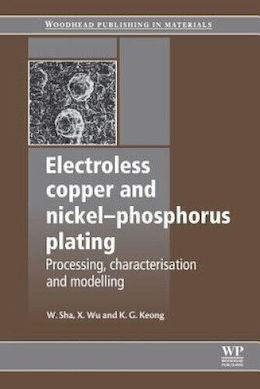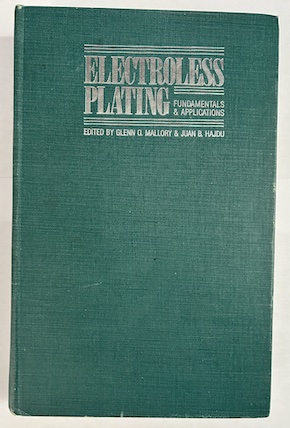
-----
Formulas for Electroless Copper Plating Baths
Q. Can anybody tell me the formula for electroless copper? (I'm plating acid copper after silver application on plastics, but I want to change to palladium & stannous chloride method because is less expensive and fast). Please I appreciate your help. I only need the formula for electroless copper.
Thanks,
- Caracas, Venezuela
2001
A. I would suggest consulting the "Metal Finishing Guidebook and Directory".

James Totter, CEF
- Tallahassee, Florida
2001
Q. Can anyone tell me the formulation of electroless copper plating?
Best regards,
- Izmir, Turkey
2002
A. Hi, cousin Murat. If possible, could you please preface your question with who you are and why you want to know, so that people will be in a better position to understand & answer the question? To my knowledge virtually all electroless copper used in the U.S.A. is proprietary (trade secret or covered by patent) rather than made to a publicly available formula. If I'm wrong, I hope another reader will correct me.

Ted Mooney, P.E.
Striving to live Aloha
finishing.com - Pine Beach, New Jersey
Ted is available for instant help
or longer-term assistance.
2002
Q. Sorry, I'm working with chrome plating on ABS plastics in Turkey. I'm using palladium/electroless nickel system. But it's very expensive. My EN solution contains nickel chloride, trisodium citrate, ammonium chloride, sodium hypophosphite and lead acetate. Can I work with silver nitrate/borane system with this formulation.
Best Regards...
- Izmir, Turkey
2002
by Sha, Wu, & Keong

on eBay or Amazon
or AbeBooks
(affil link)
A. Thanks, Murat. I'm familiar with the use of two-part silvering solutions to metallize things like the masters for vinyl record stampers where outstanding adhesion to the substrate is not required. But I am not personally familiar with using this process in lieu of the palladium chloride approach for a decorative plating-on-plastics application, where excellent adhesion is probably a requirement. But letter number 10887 discusses that prospect in some detail. Good luck.

Ted Mooney, P.E.
Striving to live Aloha
finishing.com - Pine Beach, New Jersey
Ted is available for instant help
or longer-term assistance.
2002
2003
Q. I'm a student and am looking for information about copper electroless plating. I have found many different baths formulations; for example, some Tartrate or Rochelle Salt
⇦ on
eBay
or
Amazon [affil link]
based baths include the following chemicals:
Copper sulphate:
metal source Rochelle Salt:
complexant agent Formaldehyde:
reducing agent Sodium hydroxide:
pH control additives:
stabilizers, buffers, etc.
Some of these formulations also include sodium carbonate
⇦ on
eBay or
Amazon]
, but I have not found the specific function of this chemical in the bath. What's sodium carbonate added for?
Thanks in advance for any help you can offer me.
- Caracas, Distrito Federal, Venezuela
A. Sodium carbonate may act as buffering agent at pH of solution; for example, in alkaline electroless nickel, NH4Cl can buffer the solution. NaCO3 is mixture of weak acid and strong alkali.the pH of it about 10.
Vahid Hosseini- Tehran, Iran
2003
A. I'm not sure what the function of sodium carbonate in a tartrate electroless copper bath is (maybe a buffer?), but I will tell you this: Tartrate baths are used for ease of waste treatment; the tartrate does not chelate as strongly as EDTA or quadrol. In this type of bath the tartrate (Rochelle salt) is the complexing agent, copper sulphate ⇦ on eBay or Amazon [affil link] is the metal source, formaldehyde is the reducing agent, and sodium hydroxide is a reactant.

James Totter, CEF
- Tallahassee, Florida
2003
Q. So is the EDTA or quadrol bath, being a better chelating bath, suitable for electro (rather than electroless) plating then?
Don Leamanphotographer - Orrtanna, Pennsylvania, USA
2004
A. Hi Don. To my knowledge there are no commercial quadrol or EDTA-based copper plating baths. I think James' comment implies that we want to avoid those chemicals where possible because they make proper waste treatment and disposal too difficult.
Regards,

Ted Mooney, P.E.
Striving to live Aloha
finishing.com - Pine Beach, New Jersey
Ted is available for instant help
or longer-term assistance.
2005
A. I am a Lab Technician and deal with electroless copper quite often, The formulation of the bath consists of Sodium Hydroxide, Formaldehyde, EDTA, SR, and electroless copper of course ... The levels of these chemicals are maintained using an "s" controller, which performs constant titrations of the components, and is verified by lab analysis every 4 hrs to ensure accuracy; except the electroless copper is measured in millivolts, which are determined by how much light can pass through the solution, when a sample is passed through a UV vis spectrometer. It is replenished by adding a 3-part chemistry "a, r and c".

Jason A. Brown
- Athens, Pennsylvania
Q. Hi Jason,
I am a student and I'm currently working on a senior design project on electroless copper coating. I am unfamiliar on what you mean by an "s" controller. Could you please elaborate, or maybe provide a link to where I could find more information?
Thank you.
- Columbus, Ohio
2007
Q. Anyone tell me the formulation of electroless copper plating?
Best regards,
student - tabriz, Iran
April 12, 2009
Q. Hi everyone,
I'm trying to do copper electroless. I already know the formulation of the bath (but I don't know what "SR" means in Jason's comment).
Could anybody tell me how to prepare this bath? I can't obtain it, I'm suffering stability problems.
Thanks in advance
- Las Palmas, Spain
January 22, 2010
Q. Hi
I am a lab analyst working with Electroless copper plating for Printed Circuit Board. I know the composition of the electroless copper solution except "SR". Please explain it.
Also I am interested in finding out the exact amount of EDTA in the plating solution. How I can do this? Anyone have a method to analyze the EDTA in Copper electroless copper solution?
- Islamabad Pakistan
April 28, 2012
January 23, 2015
Q. I've found several electroless copper formulas in the research papers, but I've failed to reach the same result as shown in papers, and the bath decomposed most of the time.
I don't know where and which step is wrong.
Here is the formula I was using:
copper sulphate(0.03M), EDTA (0.24M), glyoxylic acid (0.2M), 2, 2'-bipyridine (2.5ppm), volume ( 250 ml), pH:13 (adjusted by (KOH). temperature 70 °C
Here are the steps I've done:
1) added EDTA with DI water and added KOH to adjust pH to 13
2) added 2,2'-bipyridine and copper sulphate to the bath and also keep pH to 13
3) heated up the bath to 70 °C, and then added glyoxylic acid and adjusted pH to 13 with KOH.
4) put the brass substrate (with pre-treatment including cleaning/conditioning, micro etching, acid dipping, pre acid dipping, activator, and DI wash in between for all the step)
It should be about 6 µm/hr.
I followed the formula I found in the research paper, but I failed to obtain the same results (decomposition or a few nm).
Can anyone help me out with electroless copper bath?
- san jose, California, USA
A. Hi Kevin
Research papers do not indicate a fully developed stable process. They are mostly written to support an academic study and there is rarely any expectation that they will see the light of day again. (The same goes for published patents)
In order for an electroless process to work, it must be just marginally stable. Too stable and there is no deposit; too unstable and it "falls apart" To get the balance right and controllable major suppliers have invested large sums and much expertise. They are unlikely to give away the secrets of their success lightly.
Many thousand litres of commercial electroless copper are in use every day. If your interest is purely academic, I wish you luck with years of fascinating research before you. But if you are looking for a viable production process, I urge you to contact any of the major suppliers. They will not only supply a working process but also teach you how to operate it - and probably at a lower cost than buying the chemicals.

Geoff Smith
Hampshire, England
February 1, 2015
Electroless copper plating on polymers
March 26, 2015Q. I'm trying to plate polymer wafers in copper using an electroless process. I've successfully manages to get the initial plating layer down but it oxidises after a couple of hours and goes yellow and green! Are there any chemical treatments that could be done to prevent the oxidation? Or are there any chemicals I could include in the bath solution?
It's a DIY electroless process in beakers, no commercial bath and my recipe is as follows;
1 g of NaOH in 20 ml water.
1.25 g of CuSO4 in 20 ml water.
2.9 g of HCHO in 20 ml water.
40 ml water.
30 ml extra of NaOH aqueous solution to keep pH above 12.
Any ideas and suggestions would be useful!
Student - Loughborough, Leicestershire, England
A. If you have the time, you could research the formulae in the patent literature and spend tens of thousands of hours perfecting your formulae. Or, if you don't, you could buy a commercially available bath developed by companies like Macdermid, Enthone, Atotech, and many others, who have already done this for you.

Tom Rochester
CTO - Jackson, Michigan, USA
Plating Systems & Technologies, Inc.

March 30, 2015
A. Hi Alex
If by student, Loughborough you mean Loughborough University, I suggest that you take yourself to the Department of Materials Engineering where you will find Emeritus Professor David Gabe who will give you infinitely more and better advice than even this illustrious website.

Geoff Smith
Hampshire, England
April 11, 2015
A. The yellow or green tarnish is caused by an alkaline residue on the part. A brown tarnish is caused by an acidic residue.
You remove the alkaline residue after the copper bath with a water rinse and then a rinse in dilute acid. You remove the acidic residue with water.
- San Diego, California
April 28, 2017
Q, A, or Comment on THIS thread -or- Start a NEW Thread
